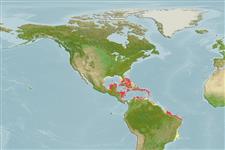>
Gobiiformes (Gobies) >
Gobiidae (Gobies) > Gobiinae
Etymology: Coryphopterus: Greek, koryphe = summit + Greek, pteron = fin, wing (Ref. 45335).
More on authors: Böhlke & Robins.
Environment: milieu / climate zone / depth range / distribution range
Ecología
marino asociado a arrecife; rango de profundidad 6 - 30 m (Ref. 9710). Tropical
Western Atlantic: southern Florida, USA and Bahamas to the Lesser Antilles (Ref. 7251). Has occasionally been recorded in northeastern Brazil (Ref. 84211).
Tamaño / Peso / Age
Maturity: Lm ? range ? - ? cm
Max length : 6.0 cm TL macho / no sexado; (Ref. 7251)
Espinas dorsales (total) : 6 - 7; Radios blandos dorsales (total) : 9 - 11; Espinas anales: 1; Radios blandos anales: 8 - 9. Translucent gray with a narrow yellow stripe, faintly edged with dusky pigment, extending posteriorly from eye, and small yellow or dusky yellow spots or short bands on snout, cheek and anteriorly on body; a row of small faint yellow spots dorsally on body (Ref. 13442).
Inhabits reef areas deeper than 6 m.
Life cycle and mating behavior
Maturities | Reproducción | Spawnings | Egg(s) | Fecundities | Larva
Benthic spawner.
Robins, C.R. and G.C. Ray, 1986. A field guide to Atlantic coast fishes of North America. Houghton Mifflin Company, Boston, U.S.A. 354 p. (Ref. 7251)
IUCN Red List Status (Ref. 130435)
Threat to humans
Harmless
Human uses
Pesquerías: comercial; Acuario: Comercial
Herramientas
Special reports
Download XML
Fuentes de Internet
Estimates based on models
Preferred temperature (Ref.
123201): 26.4 - 28.2, mean 27.5 °C (based on 597 cells).
Phylogenetic diversity index (Ref.
82804): PD
50 = 0.5001 [Uniqueness, from 0.5 = low to 2.0 = high].
Bayesian length-weight: a=0.01023 (0.00477 - 0.02194), b=3.02 (2.84 - 3.20), in cm total length, based on LWR estimates for this (Sub)family-body shape (Ref.
93245).
Nivel trófico (Ref.
69278): 2.0 ±0.00 se; based on food items.
Resiliencia (Ref.
120179): Alto, población duplicada en un tiempo mínimo inferior a 15 meses (Preliminary K or Fecundity.).
Fishing Vulnerability (Ref.
59153): Low vulnerability (10 of 100).
Nutrients (Ref.
124155): Calcium = 194 [98, 437] mg/100g; Iron = 1.15 [0.55, 2.23] mg/100g; Protein = 17.9 [15.8, 19.6] %; Omega3 = 0.137 [0.061, 0.273] g/100g; Selenium = 25.8 [12.5, 56.7] μg/100g; VitaminA = 107 [24, 421] μg/100g; Zinc = 3.16 [2.00, 4.85] mg/100g (wet weight);
